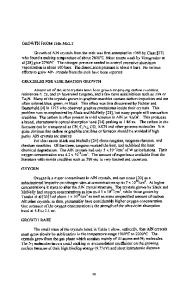Nanoindentation Behavior of Gold Single Crystals
- PDF / 146,285 Bytes
- 7 Pages / 612 x 792 pts (letter) Page_size
- 103 Downloads / 429 Views
U8.30.1
Nanoindentation Behavior of Gold Single Crystals Martha M. McCann and Sean G.Corcoran Virginia Tech, Department of Materials Science and Engineering, Blacksburg, VA 24061 ABSTRACT Nanoindentation is an increasingly used tool to investigate the mechanical properties of very small volumes of material. It is usually a very consistent measure of the elastic response of material and plastic response to point contact loading. Nanoindentation experiments on gold single crystals display tremendous variation in the residual deformation. The depth of penetration, which is vital in hardness determination, can differ by as much as 100%. This large variability of the load-depth data is usually explained by surface differences such as crystal orientation, oxide thic kness, presence of multiple solid phases, or contamination layers. None of these reasons apply to the variation observed in the gold system. The onset of plastic deformation is observed at a stress level on the order of the theoretical yield strength. The difference in depth of penetration is independent of this elastic -plastic transition. This paper reports on attempts to correlate the depth of penetration to surface feature size and surface preparation procedures. BACKGROUND Nanoindentation load-depth curves are sometimes referred to as “material fingerprints” for each material behaves slightly differently. As with any good characterization tool, indentation behavior should be reproducible or otherwise enable differentiation of material heterogeneities. In the nanometer regime, atomic scale defects and impurities may have a dramatic effect on hardness tests. Factors such as the location of the indent, surface preparation, surface orientation, the radius of the indenter and even the tip material play important role in the information gathered [1-6]. The mechanical response of small volumes of material is more sensitive to oftenoverlooked characteristics such as the surface energy and/or dislocation density [7-9]. Oxides, absorbed species, compositional changes and even exposure to the environment can have tremendous local influence on the mechanical properties [10-13]. Nanoindentation is also very sensitive to factors such as surface texture, residual surface stress, thickness of thin films, and the presence of oxides where appropriate [14-18]. The explanations for the unusual response to point loading are far from resolved but rather test the knowledge of fundamental theories of material behavior. EXPERIMENTAL All experiments were performed on Au (111) single crystals (99.99%), purchased from Monocrystals Inc. [19]. Gold was chosen as a model material because it is a well characterized FCC metal that does not form a natural oxide. Single crystals eliminate grain boundary issues. Surface preparation techniques are well known from work done in the electrochemical field. There are three stages to the surface preparation of gold. Starting with the most macroscopic, the crystal is mechanically polished using alumina paste and soft cloth for precious metals. Nex
Data Loading...











